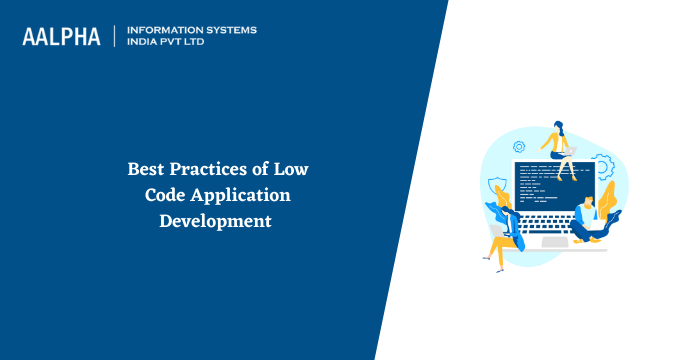Great Facts For Choosing Low-Code Platform Sites
Great Facts For Choosing Low-Code Platform Sites
Blog Article
Advantages Of Low Code Application Development For Non-Developers
Due to a number of important factors, Low-Code Application Development is accessible to people who are not developers. They are also known as "citizen designers."
Drag-and–Drop Builders : Low-code platforms offer drag-and–drop interfaces which enable people who are not developers, and without the need to write code, to build visually appealing applications. This makes it much easier for those with less technical expertise to be involved in the process of development.
WYSIWYG Editors: "What You See Is What You Receive" editors let users build interfaces and workflows a manner that closely resembles the actual product, which makes it much easier to use and understand.
Simplified Workflow and Logic Design
Visual Workflow Modeling: Users are able to develop business processes and apply logic using visual flowcharts and models that are more user-friendly than traditional coding methods.
Low-code platforms usually come with pre-built logic components (e.g. the conditional statements, loops) which eliminate the requirement for complex coding.
Reusable Components and Templates:
Libraries of pre-built templates: Many low-code platforms offer templates for the most common types of applications, enabling non-developers to start from a solid base and customize as needed.
Reusable widgets and modules The development of web pages is made simpler by using reusable components and modules. This reduces the requirement for technical expertise.
Guided Development and Tutorials:
Step-by-Step Instructions Platforms typically offer on-screen tutorials, guided development paths as well as other tools to assist non-developers create applications.
Interactive Tutorials Interactive tutorials are hands-on and interactive, which help users to learn through doing. This boosts the confidence of users in the platform.
Integration with Tools Already in Use:
Easy Integration - Low-code platforms can be easily integrated with existing business tools and systems (e.g. ERP, CRM) that give even non-developers to build apps that are compatible within their workflows.
APIs and Connectors Built-in APIs and connectors simplify the integration process and allow non-developers to connect their apps with external services without the need for complicated programming.
Collaboration Features:
Team Collaboration: real-time collaboration, shared workspaces, and shared workspaces allow business analysts, non-developers and other stakeholders to effectively collaborate with developers who are professionals.
Role Based Access Control: You can give non-developers certain roles with the appropriate access level, so they can be part of the development process without compromising on security or functionality.
Automated testing and debugging
Built-in Testing Tools: Platforms that are low-code typically come with built-in testing and debugging tools that can automate these procedures, making it much easier for non-developers to ensure their apps function properly.
Error Highlighting: When problems occur the platform highlights any mistakes and suggests solutions, guiding non-developers through troubleshooting techniques.
The ability of low-code applications to facilitate development for those who are not developers is its main benefit. Low-code platforms allow business users to participate actively in the development and maintenance of apps by offering visual tools as well as a guiding user experience. This is a bridge between technical implementation and business demands. Follow the recommended consultant about Low-code Platform for application development for site tips including ms azure sql, rapid applications, application modernization software, cross platform app development, develop mobile application, driver jdbc, low code development platforms, app modernization, low code development platforms, rapid app development and more.
Benefits Of Low Code Application Development For Governance And Security
Low-code applications offer several benefits in terms of cybersecurity and governance, which is crucial to ensure that all applications are well-managed, managed and in compliance throughout their livescycle. These are the main benefits.
Unified Manage Console: Lowcode platforms usually have a management console which allows administrators to manage and supervise applications.
Role-Based Access Control RBAC: These platforms are equipped with robust role-based controls that allow administrators to define access policies. This guarantees that only authorized users can access or modify particular elements of an application.
Compliance and Regulatory Adherence
Built-in Compliance Features: A lot of low-code platforms are built to comply with industry standards as well as regulations (e.g., GDPR, HIPAA). They offer frameworks and tools to ensure that applications comply with standards.
Audit Trails & Logging: Complete audit trails and logs can be integrated to allow companies to monitor changes as well as monitor access to ensure compliance.
Improve Security Measures
Data Encryption. Low code platforms usually provide encrypted data built-in, both in transit and when at rest. This safeguards sensitive data.
Security Certifications: A lot of low-code providers have security certifications (e.g., ISO 27001, SOC 2) that prove their compliance with high security standards, providing extra security for users.
Automated security Updates
Regular updates and patching Low-code platforms can handle the majority of security patches and updates in a way. They make sure that applications are safe from the most recent attacks without requiring developers to intervene manually.
Security Monitoring Tools: These tools provide alerts in real-time and insights into security concerns that might be present.
Data Governance
Data Access Policy: These platforms allow companies define and enforce rules for data access, making certain that only authorized users can access data and the data is utilized in a safe manner.
Data Masking and Anonymization: The built-in tools to mask and anonymize data help protect sensitive information in development and testing environments.
Consistent Application Management
Pipelines for Deployment and Development: Low-code platforms often provide integrated development and deployment pipelines which include security checks, which ensure security is maintained throughout the application lifecycle.
Version Control: A unified version control system can help manage changes, allowing any changes that are made to an application to be tracked. If needed the changes can be reversed and the integrity of the application ensured.
User authentication authorization
Single Sign-On (SSO). Support for advanced authentication and single sign-on is simple and improves security.
Multi-Factor Authentication Numerous platforms are equipped with built-in functionality for multi-factor verification and provide an additional layer for security.
Monitoring of Policy Enforcement
Low-code platforms include templates for policies predefined and can help organizations implement security and governance guidelines.
Tools for Monitoring Compliance: These tools track and report continuously on the status of compliance. They make it easier to spot issues and tackle them in a proactive manner.
Integration with Existing Security Infrastructure:
Seamless Integration: Low-code platforms have been designed to be integrated with existing security tools and infrastructure, like identity management systems and SIEM (Security Information and Event Management) solutions, and firewalls.
API Security: Built-in API security features protect information, guarantee integrity of the application and provide secure integrations.
Training and Best practices
Guided Best Practices : Many platforms provide guidelines and best practices to help non-developers adhere with security standards.
Security Training: Some companies of low-code provide training and resources on security that will help users understand how to build and maintain secure applications.
Overall the governance and security benefits of low-code development make sure that applications are created and maintained in a safe, compliant, and controlled method. These platforms comprise the tools and frameworks required to supervise and control development of applications, as well as safeguarding sensitive information while ensuring legal compliance and enforcing the policies. Follow the recommended he said about Enterprise application development with Low-code Platform for more examples including app modernisation, application modernization software, rapid applications, developing mobile apps, driver jdbc, azure sql, low code development platforms, azure sql databases, develop mobile application, app dev platform and more.
Benefits Of Low-Code App Development In Terms Limitations And Customization
The low-code method is an approach that is balanced and allows for substantial customization and overcomes issues. These are the main advantages: Handling the limitations
In overcoming Complexity Barriers:
Simple development: Platforms that use low-code minimize the amount of work by supplying pre-built components and templates which allow quicker development and deployment for more complex applications.
Guided Workflows - A lot of platforms offer wizards or workflows that assist developers with difficult procedures. This minimizes the chance of errors and assures accuracy.
Solutions to scale:
Built-in Scalability: Low-code systems usually have features that support an scalable architecture, which allows apps to handle higher load without significant redevelopment.
Performance Monitoring: The integrated instruments for monitoring performance and optimization can to ensure that applications are effective as they expand.
Security and Compliance
Low-code platforms have built-in security options, such as security access control based on role, encryption, and automated checks for compliance. These features address most common security concerns.
Platforms are continuously updating their security protocols and methods of conformity, which assures that the applications are secure against new threats.
Customization:
Extensibility:
Custom Code Integration: Low-code platform often allows the integration of custom codes (e.g. JavaScript, Python) which enables developers to enhance the capabilities beyond the standard offerings.
Custom Modules and Plugins: Developers have the option of creating custom modules or plugins in order to modify specific functionality to fit unique business needs.
APIs and Integration
API Support: Full API support is available to enable seamless integration and connectivity with other systems.
Third-Party Services: Low-code platform typically provides pre-built connections to popular services provided by third-party providers making integration and customizing easier.
Flexible UX/UI Designs:
Customizable user interfaces: Developers can modify and design the user interfaces in order to meet specific branding requirements and requirements for usability, resulting in the user with a customized experience.
Responsive design: The capability to adapt applications to different screen sizes and devices is built-in.
The process of customizing Business Logic is easy:
Visual Workflow Designers: These visual tools are used to customize and create workflows, as well as business logic, which allows developers to develop complex, custom-designed processes.
Conditional Logic and scripting: Platforms allow for the use of conditional logic and custom scripting to manage particular business rules.
Data Management
Custom Data models: Developers can to define custom data model that meet the specific requirements of an application and ensure that data handling meets business requirements.
Advanced Data Processing: Integration with sophisticated tools and capabilities for data processing allow customization in how the data is analyzed, and utilized within your application.
How do you balance customization with limitations:
Frameworks and Standards
Best Practices: Low-code platform encourages adherence to standards and industry best practices. This is helpful in maintaining high-quality, scalable and secured applications.
Governance Frameworks. Built in governance frameworks can help ensure that customizations are not damaging to the security, integrity or security of the application.
Iterative Development and Feedback
Rapid prototyping: By being in a position to quickly prototype and test their modifications, developers are able to refine their designs based on feedback from users to improve the application.
Low-code platforms enable constant improvement through the continuous improvement of their design and enhancements the platform as requirements of business evolve.
User Empowerment
Giving Citizen developers the tools they need: The low-code platform's intuitive interfaces allow non-developers make customizations. This boosts the number of contributors able to improve and customize applications.
Training and Support: A lot of platforms provide extensive training and support that can assist users with making efficient customizations, without compromising application stability or performance.
Overall, low code application development offers a solid framework that can address the limitations and provide ample possibilities for customization. This ensures that companies are able to create and maintain apps that are both functional and customized to meet their particular needs, all while maintaining high standards of security, quality, and scalability.